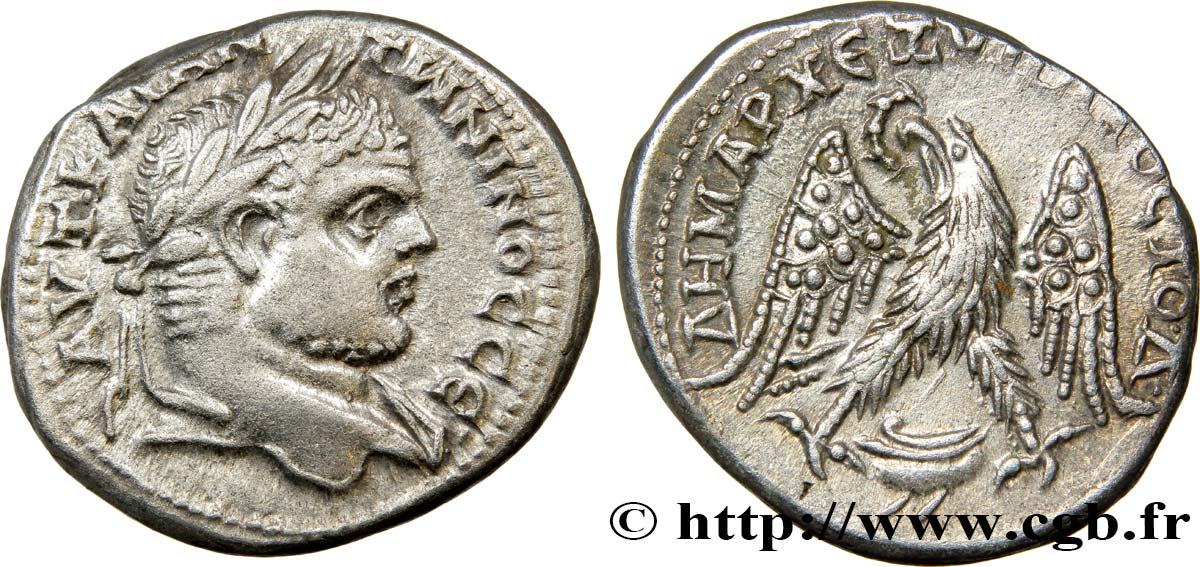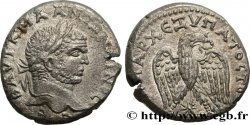E-auction 102-53626 - bpv_205127 - CARACALLA Tétradrachme syro-phénicien
You must signin and be an approved bidder to bid, LOGIN TO BID. Accounts are subject to approval and the approval process takes place within 48 hours. Do not wait until the day a sale closes to register. Clicking on « bid » constitutes acceptance of the terms of use of cgb.fr private e-auctions.
Bids must be placed in whole Euro amounts only. The sale will start closing at the time stated on the item description; any bids received at the site after the closing time will not be executed. Transmission times may vary and bids could be rejected if you wait until the last second. For further information ckeck the E-auctions F.A.Q.
NO BUYER'S FEE.
NO BUYER'S FEE.
| Estimate : | 150 € |
| Price : | 80 € |
| Maximum bid : | 81 € |
| End of the sale : | 30 March 2015 16:00:00 |
| bidders : | 10 bidders |
Type : Tétradrachme syro-phénicien
Date: 215-217
Mint name / Town : Berytus, Phénicie
Metal : billon
Diameter : 24 mm
Orientation dies : 12 h.
Weight : 11,89 g.
Coments on the condition:
Exemplaire sur un petit flan ovale, légèrement décentré sur les légendes. Beau portrait. Revers de style fin bien venu à la frappe. Jolie patine de collection ancienne avec de minuscules oxydations cuivreuses au droit sur le visage
Catalogue references :
Predigree :
Cet exemplaire est le 1293_095 de la base TSP
Obverse
Obverse description : Buste lauré de Caracalla à droite, drapé sur l’épaule gauche (O*2).
Obverse legend : AUT. KAI. AN-TwNINOS SE, (Autokrator Kaisar Antwninos Sebastos)
Obverse translation : (L'empereur césar Antonin auguste).
Reverse
Reverse description : Aigle debout à droite, les ailes déployées, la tête et la queue tournées à gauche, tenant dans son bec une couronne perlée ; entre les pattes, la poupe et les rames-gouvernails d’un navire allant à droite.
Reverse legend : DHMARC EX UPATOS TO D
Reverse translation : (Revêtu de la puissance tribunitienne consul pour la quatrième fois).
Commentary
Rubans de type 2. Ce type se définit par un début de drapé sur le buste. Depuis la parution du Prieur, une tentative de séparer ce type par grandes familles de graveurs a été tentée, cet exemplaire restant du graveur standard, donc 1293. En revanche, la pièce illustrée dans le Prieur correspond à un graveur actuellement référencé sous le 1293C.
Les tétradrachmes attribuées à Beyrouth, Berytus, se répartissent en deux grandes séries car en deux symboles. Tout d’abord, la proue de navire à droite, importante série en volume, plusieurs graveurs différents, tant pour les avers que pour les revers, aucune variation du type, pas de frappe pour Macrin ni pour Diaduménien. Par ailleurs aucune preuve factuelle qu’il s’agisse bien de frappes pour Beyrouth : ce ne sont pas les ports qui manquent dans la région et nous n’avons trouvé aucun lien avec les bronzes de la ville. Remarquons pourtant que la poupe qui est représentée avec ses deux gouvernails (notons une erreur dans le Prieur, qui dit prow donc proue alors qu’il s’agit de la poupe d’un navire) semble bien celle d’un navire de commerce, très rond de coque, et non pas d’un navire de guerre, encore moins d’une galère. L’émission serait donc celle d’un port de commerce plutôt que d’un port militaire comme Laodicée ou Séleucie.
L’autre série, avec le dauphin et le trident, excessivement rare, correspond parfaitement à la ville tant pour le symbole, que l’on retrouve sur des bronzes, que pour les graveurs des portraits, que l’on retrouve aussi sur des bronzes.
Peut-on imaginer que les frappes à la poupe de navire furent les taxes payées par l’administration du port de Beyrouth ? Mais alors, pourquoi aucune frappe pour Macrin, qui a bien dû lever des fonds pour payer la rançon de la Pax Fundata cum Persis ?
On note que les sigma sont gravés en C.
Dans la base TSP maintenue par Michel Prieur, quatre-vingt sept exemplaires sont maintenant répertoriés pour tous les graveurs.
Type 2 ribbons. This type is defined by the beginning of draping on the bust. Since the publication of the Prior, an attempt has been made to separate this type by large families of engravers, this example remaining from the standard engraver, therefore 1293. On the other hand, the piece illustrated in the Prior corresponds to an engraver currently referenced under 1293C.
The tetradrachms attributed to Beirut, Berytus, are divided into two large series because of two symbols. First of all, the ship's prow on the right, a large series in volume, several different engravers, both for the obverse and the reverse, no variation of the type, no strike for Macrinus or for Diadumenianus. Furthermore, there is no factual evidence that these were strikes for Beirut: there is no shortage of ports in the region and we have found no link with the bronzes of the city.. Let us note, however, that the stern which is represented with its two rudders (let us note an error in the Prior, who says prow whereas it is the stern of a ship) seems indeed that of a merchant ship, very round hull, and not of a warship, still less of a galley. The issue would therefore be that of a commercial port rather than a military port like Laodicea or Seleucia..
The other series, with the dolphin and the trident, extremely rare, corresponds perfectly to the city both for the symbol, which is found on bronzes, and for the engravers of the portraits, which are also found on bronzes..
Can we imagine that the strikes on the stern of the ship were the taxes paid by the administration of the port of Beirut? But then, why no strikes for Macrinus, who must have raised funds to pay the ransom of the Pax Fundata cum Persis? We note that the sigmas are engraved in C.
In the TSP database maintained by Michel Prieur, eighty-seven examples are now listed for all engravers
Les tétradrachmes attribuées à Beyrouth, Berytus, se répartissent en deux grandes séries car en deux symboles. Tout d’abord, la proue de navire à droite, importante série en volume, plusieurs graveurs différents, tant pour les avers que pour les revers, aucune variation du type, pas de frappe pour Macrin ni pour Diaduménien. Par ailleurs aucune preuve factuelle qu’il s’agisse bien de frappes pour Beyrouth : ce ne sont pas les ports qui manquent dans la région et nous n’avons trouvé aucun lien avec les bronzes de la ville. Remarquons pourtant que la poupe qui est représentée avec ses deux gouvernails (notons une erreur dans le Prieur, qui dit prow donc proue alors qu’il s’agit de la poupe d’un navire) semble bien celle d’un navire de commerce, très rond de coque, et non pas d’un navire de guerre, encore moins d’une galère. L’émission serait donc celle d’un port de commerce plutôt que d’un port militaire comme Laodicée ou Séleucie.
L’autre série, avec le dauphin et le trident, excessivement rare, correspond parfaitement à la ville tant pour le symbole, que l’on retrouve sur des bronzes, que pour les graveurs des portraits, que l’on retrouve aussi sur des bronzes.
Peut-on imaginer que les frappes à la poupe de navire furent les taxes payées par l’administration du port de Beyrouth ? Mais alors, pourquoi aucune frappe pour Macrin, qui a bien dû lever des fonds pour payer la rançon de la Pax Fundata cum Persis ?
On note que les sigma sont gravés en C.
Dans la base TSP maintenue par Michel Prieur, quatre-vingt sept exemplaires sont maintenant répertoriés pour tous les graveurs.
Type 2 ribbons. This type is defined by the beginning of draping on the bust. Since the publication of the Prior, an attempt has been made to separate this type by large families of engravers, this example remaining from the standard engraver, therefore 1293. On the other hand, the piece illustrated in the Prior corresponds to an engraver currently referenced under 1293C.
The tetradrachms attributed to Beirut, Berytus, are divided into two large series because of two symbols. First of all, the ship's prow on the right, a large series in volume, several different engravers, both for the obverse and the reverse, no variation of the type, no strike for Macrinus or for Diadumenianus. Furthermore, there is no factual evidence that these were strikes for Beirut: there is no shortage of ports in the region and we have found no link with the bronzes of the city.. Let us note, however, that the stern which is represented with its two rudders (let us note an error in the Prior, who says prow whereas it is the stern of a ship) seems indeed that of a merchant ship, very round hull, and not of a warship, still less of a galley. The issue would therefore be that of a commercial port rather than a military port like Laodicea or Seleucia..
The other series, with the dolphin and the trident, extremely rare, corresponds perfectly to the city both for the symbol, which is found on bronzes, and for the engravers of the portraits, which are also found on bronzes..
Can we imagine that the strikes on the stern of the ship were the taxes paid by the administration of the port of Beirut? But then, why no strikes for Macrinus, who must have raised funds to pay the ransom of the Pax Fundata cum Persis? We note that the sigmas are engraved in C.
In the TSP database maintained by Michel Prieur, eighty-seven examples are now listed for all engravers








 Report a mistake
Report a mistake Print the page
Print the page Share my selection
Share my selection Ask a question
Ask a question Consign / sell
Consign / sell
 Full data
Full data









